The presence of the healthy women and sane sexuality in India ought to influenced Indian life in a beneficial way. Unfortunately, the judging about this subject is difficult enough as ancient Indian history in the whole and specially the Buddhist period, is typified with lack of reliable historical documents.
However, this fact itself is a good sign. I mean that earliest written documents in general world history are either book-keeping reports or decrees and laws, or
religious myths, or eulogies of rulers. Thus, the main message the first scripts carry to us through the time is that vanity, avidity and compulsion over intellectuals (the authors of the earliest texts) appeared.
-
By the way this universal rule have determined the notion that particular politics, economy and laws are the motors of the history. I suppose this notion is wrong as there are some stronger forces and factors
in human life and history.
Now let's return to ancient Indian history. Although it is known mostly from archeology and foreign written sources - chiefly Greek, these afford us sufficient material for
judgment about importance of the Buddhist period Of Indian history.

![]() So, Greek sources tell us that Alexander the Great had to persuade his brave and invincible but avaricious soldiers into the conquest of India, this country presented no attraction for them so far. In India there was nothing valuable for them as well as for Alexander himself. He only wanted to complete logically the conquest of all the known Orient. We know that he failed in the persuasion.
So, Greek sources tell us that Alexander the Great had to persuade his brave and invincible but avaricious soldiers into the conquest of India, this country presented no attraction for them so far. In India there was nothing valuable for them as well as for Alexander himself. He only wanted to complete logically the conquest of all the known Orient. We know that he failed in the persuasion.
It was the very beginning of the Buddhist epoch. And several centuries later India became
the wonderland that drew people from
all over the world as though a magnet.

![]()

![]() Remember the phenomenal
gravitation towards India during the whole Middle Ages and New Time that forced bold European voyagers
to sail through the dire seas for Indian wares. This gravitation has
determined the face of
the modern world. In particular, America was discovered while search for an alternative sea way to India and China (another area of Buddhist influence, the opposite side of the Himalayas), also American
pioneers had the task to support the searches for a strait to west.
Remember the phenomenal
gravitation towards India during the whole Middle Ages and New Time that forced bold European voyagers
to sail through the dire seas for Indian wares. This gravitation has
determined the face of
the modern world. In particular, America was discovered while search for an alternative sea way to India and China (another area of Buddhist influence, the opposite side of the Himalayas), also American
pioneers had the task to support the searches for a strait to west.

![]()

![]() Usually we do not appreciate the importance of Indian culture because Europeans learnt its achievements from Middle Eastern middlemen. For instance, so-called
Arabic numerals are Indian as a matter of fact, also
Scheherazade's
tales
doubtlessly stem from Indian verbal tradition. The amorphous term Orient conceals what originally belonged to India.
Besides, India's former grandeur had been destroyed to the time when Europeans
reached that country so long wished for.
Usually we do not appreciate the importance of Indian culture because Europeans learnt its achievements from Middle Eastern middlemen. For instance, so-called
Arabic numerals are Indian as a matter of fact, also
Scheherazade's
tales
doubtlessly stem from Indian verbal tradition. The amorphous term Orient conceals what originally belonged to India.
Besides, India's former grandeur had been destroyed to the time when Europeans
reached that country so long wished for.
See related resources:
Now let's try to understand what factors resulted in that miraculous metamorphosis in India during the Buddhist period.
Could they be the rulers' acts, laws, or religious doctrines?
I think all these could only be consequences, but the cause was the presence of the healthy
women's rid of the common female hormonal disturbance, which causes women's malignance
being the prime scourge of of any moral evil.
All the legends carry sad imprints of destructive changes in ascetic life.
Apparently, they were fixed on the decline of Buddhist
period of Indian history the happy time when in India there were men and
women enjoying pure and natural life. Here is short overview of such
legends.
- Savitri
and Satyavan
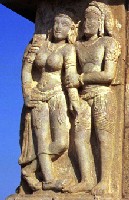
![]() This is one of the finest touching stories of female loyal love. However, it
contains some sad signs of bad changes: Savitri falls in love with the ill
man (Satyavan) doomed to die in a year. Thus, we can state a case of the sexual
mis-selection here, which seemingly signifies that ascetic women had
become hormonally disturbed.
This is one of the finest touching stories of female loyal love. However, it
contains some sad signs of bad changes: Savitri falls in love with the ill
man (Satyavan) doomed to die in a year. Thus, we can state a case of the sexual
mis-selection here, which seemingly signifies that ascetic women had
become hormonally disturbed.
An illustrated but more adapted version of this story (as well as some other
stories) is presented in IndoLink
site of Indian emigrants in the USA.
- The
Recognition of SHakuntala
- Famous drama by great Ancient Indian poet Kalidasa.
This drama is based on earlier legends according to which Shakuntala (also Sakuntala)
was born from the union of an ascetic and an apsara (a nymph of
Indian mythology, originally female ascetic, evidently), and later gave
birth to her son in an ascetic settlement.
The legend reflects the destructive changes in life of Ancient Indian
ascetics - people of arms begun to marry beautiful female ascetics and take
them away from the hermitages.
There is a shortened version of Story
of Shakuntala.
- The
Ramayana
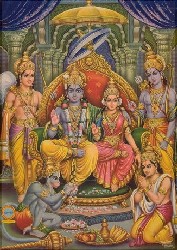
![]() One of two greatest Ancient Indian eposes. Its heroes Rama and his consort
Sita as well as his brother Lakshmana are pictured living in a forest
hermitage near the Himalayas. This fact was explained with the exile because
people of the later epoch could not assume that these great heroes lived so
plain (compare the later Hindu picture right).
One of two greatest Ancient Indian eposes. Its heroes Rama and his consort
Sita as well as his brother Lakshmana are pictured living in a forest
hermitage near the Himalayas. This fact was explained with the exile because
people of the later epoch could not assume that these great heroes lived so
plain (compare the later Hindu picture right).
The whole story is devoted to abduction of a beautiful female from ascetic
hermitage by Ravana the evil king of ruffians.
The available web versions pass by interesting episode of villain Ravana's
persuasions. When he attempts to persuade beautiful Sita into leaving the
forest hermitage for his royal palace, he calls her wide-hipped, rich-hipped.
This story ends happy, but in fact small paradises of ascetic hermitages
were destroyed by aliens.
There is an illustrated but more adapted version of The
Ramayana.-
- Sudama
- This story also reflects the bad changes in life of ascetics. The
matter is that before ascetics were as respectable as kings in Indian
society, while this story portrays another state.
|
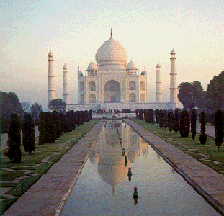 |
The shrine of love,
the memorial of the foreign yoke |
The material and spiritual prosperity of India attracted not only Buddhist
pilgrims, scientists and merchants, but also jealous and fierce conquerors and
simple criminals who have destroyed its prosperity at last.
The story of the famous Taj Mahal exemplifies this trend.
This famous building regarded as the shrine of love, is the mausoleum of Mumtaz, the favorite of harem of Shah Jahan, one of foreign (Mughal) despot of India. The name Taj Mahal means 'crown (peak) of Mughals.'
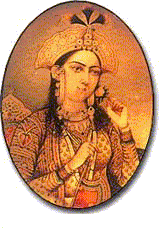 Mumtaz was a very imperious woman, and apparently way not healthy.
She had died young enough, and her last will was just to be buried in the luxurious tomb which was fulfilled and from which we can
conclude that the cause of her death was not her modesty.
Mumtaz was a very imperious woman, and apparently way not healthy.
She had died young enough, and her last will was just to be buried in the luxurious tomb which was fulfilled and from which we can
conclude that the cause of her death was not her modesty.
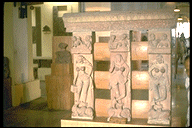 Taj Mahal
is really a very beautiful monument, but appreciating its artificial splendor we should
bear in mind that this mausoleum of the insane woman was designed by subdued artists whose art
had been developed by creators of
Buddhist stupas decorated with the immortal images of stunning Yakshis. Taj
Mahal was built as though in place of
the stupas as well as ill women like Mumtaz came in place of Yakshis themselves.
Taj Mahal
is really a very beautiful monument, but appreciating its artificial splendor we should
bear in mind that this mausoleum of the insane woman was designed by subdued artists whose art
had been developed by creators of
Buddhist stupas decorated with the immortal images of stunning Yakshis. Taj
Mahal was built as though in place of
the stupas as well as ill women like Mumtaz came in place of Yakshis themselves.
The dominance of people like Mumtaz and Shah Jahan over India just undermined all the good and beautiful in that country.
According to a legend Shah Jahan ordered to chop off the hands of the architect of this
miraculous building, so that the latter could not create anything similar. It is only
a legend, but it carries the spirit of the epoch. Besides, in any case we know names of
the despot and his insane wife, but not of the honorable wizards who have made this wonder.
Summing up, we can say that Mumtaz' mausoleum is also a splendid tomb of India's great past.




